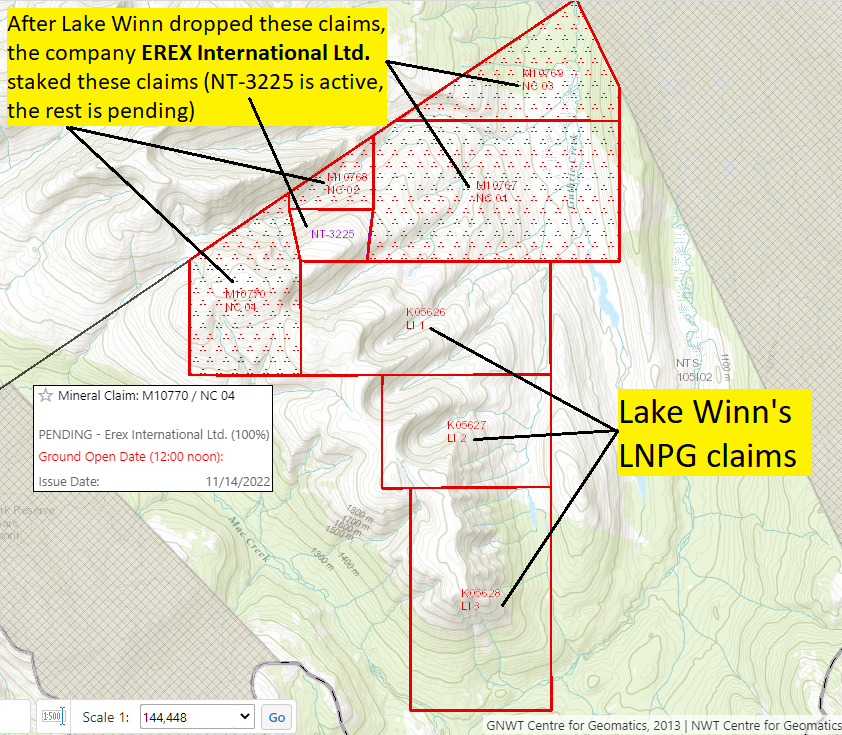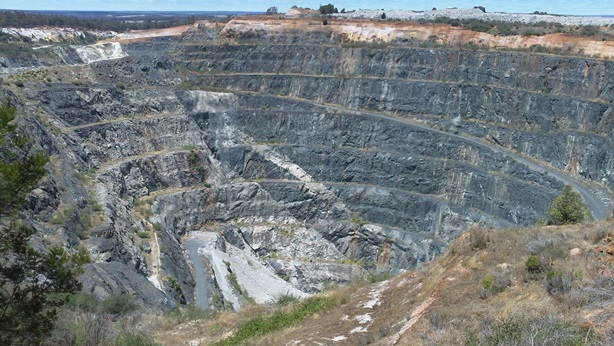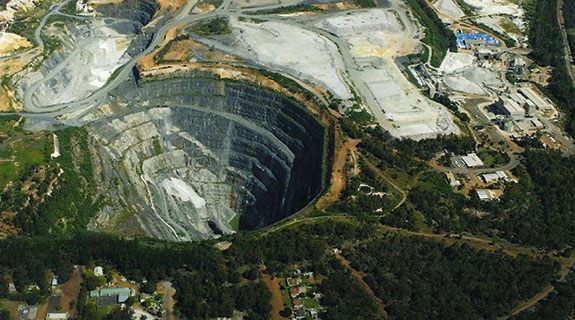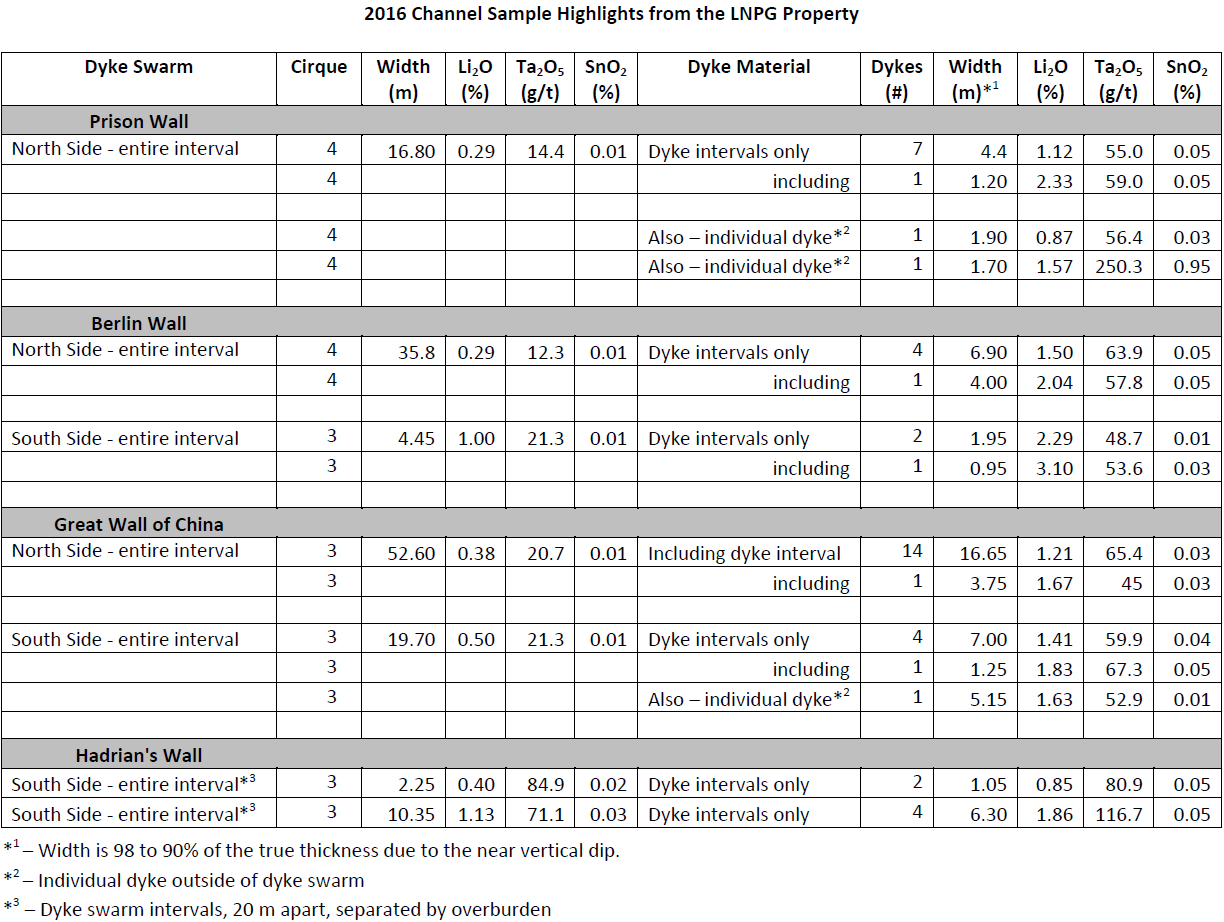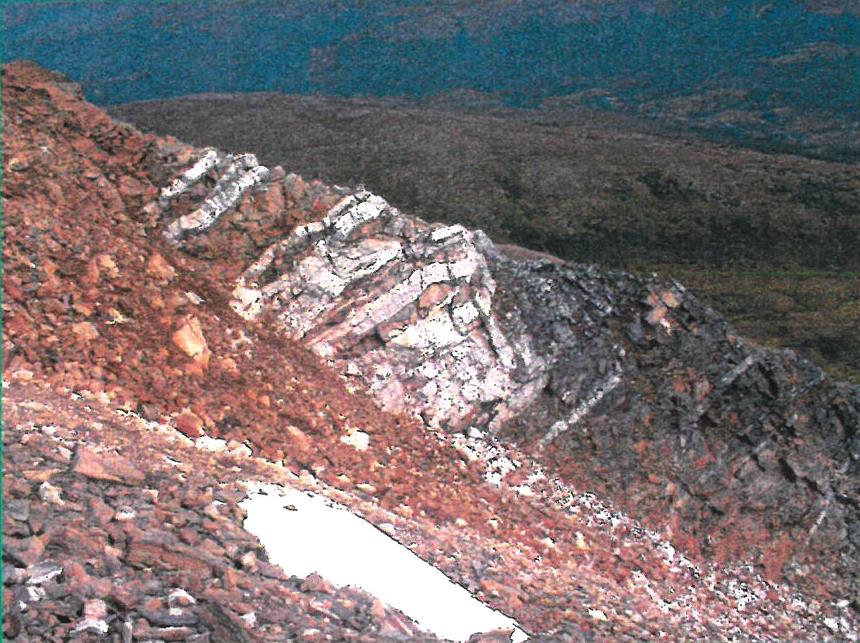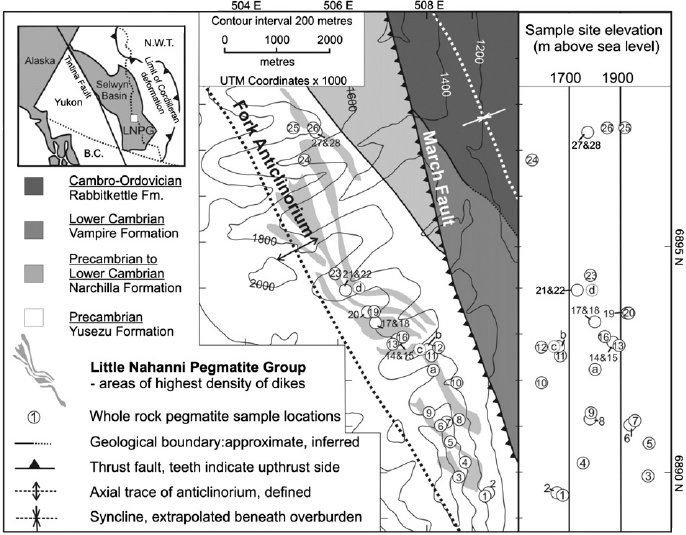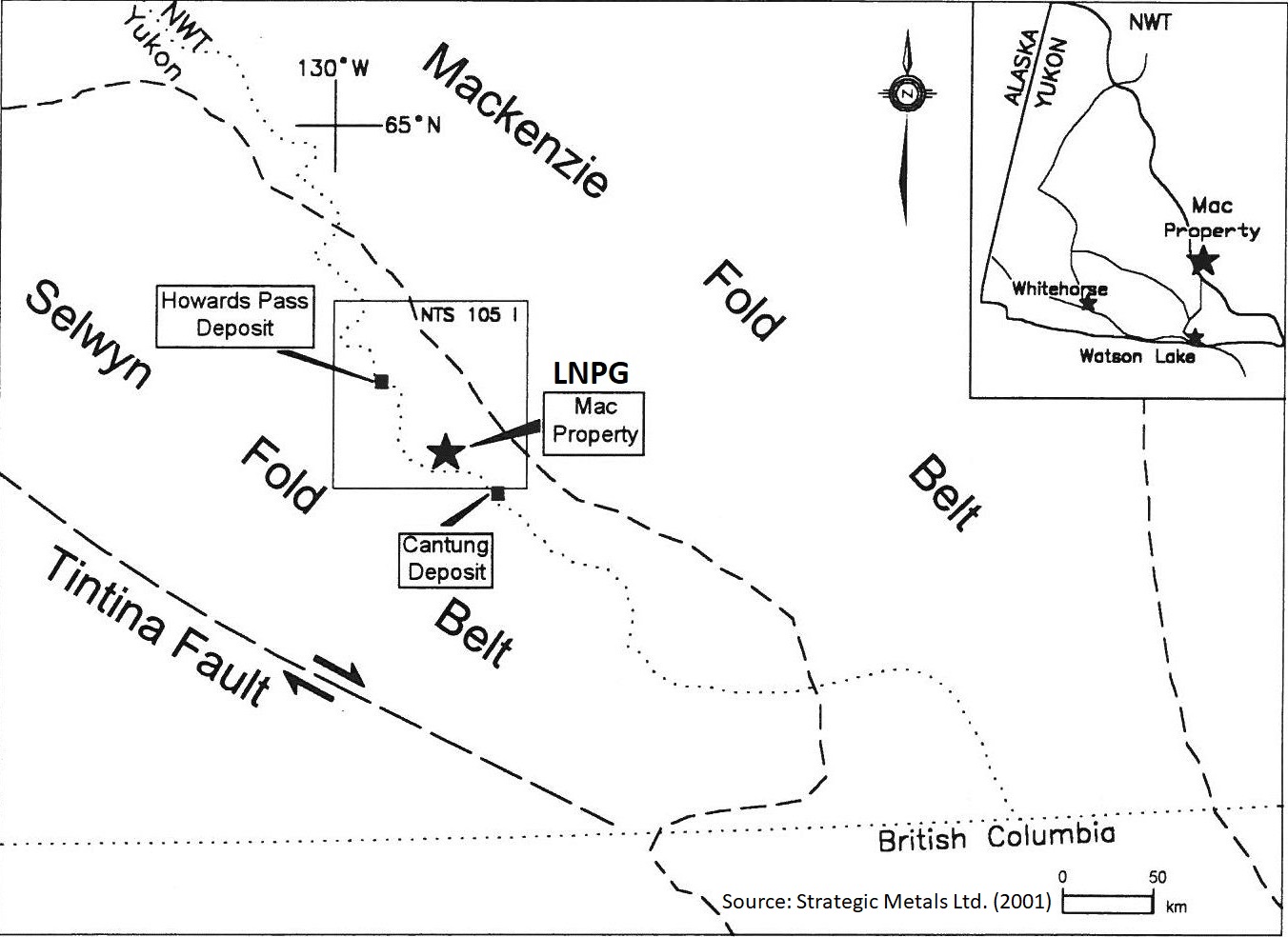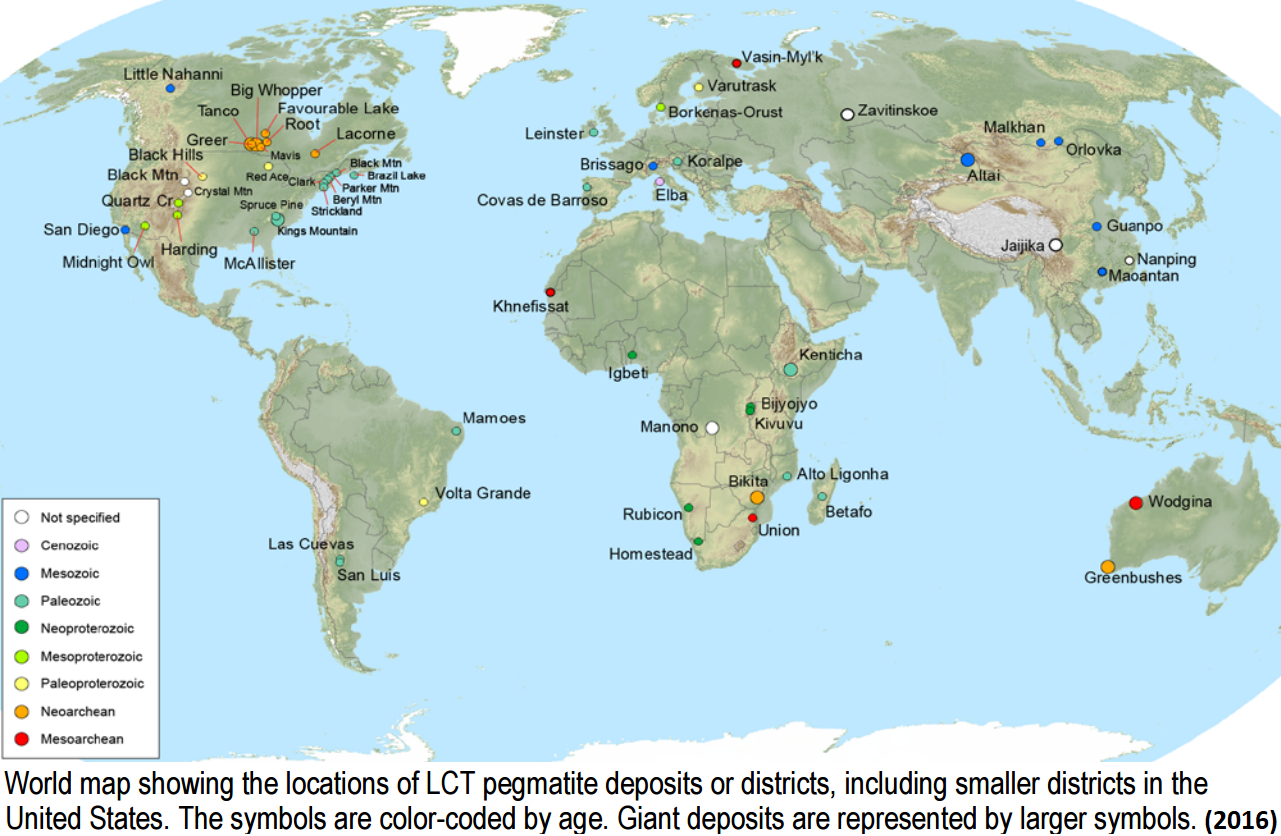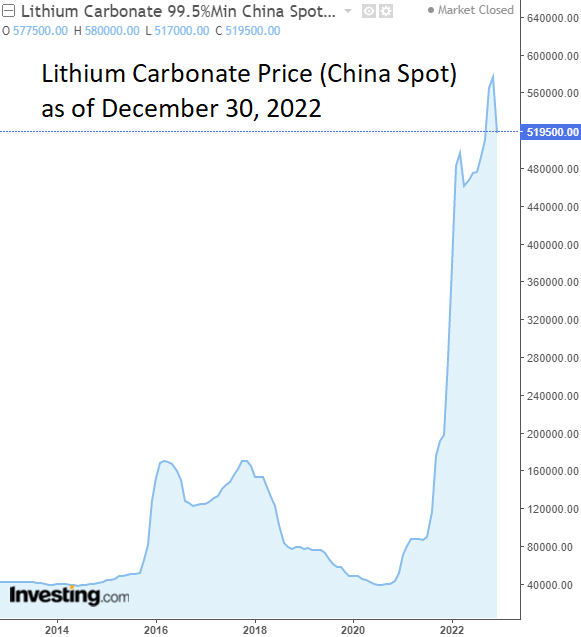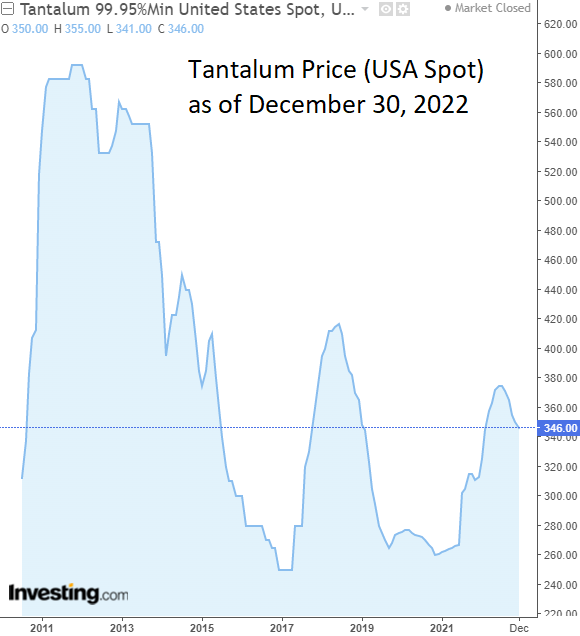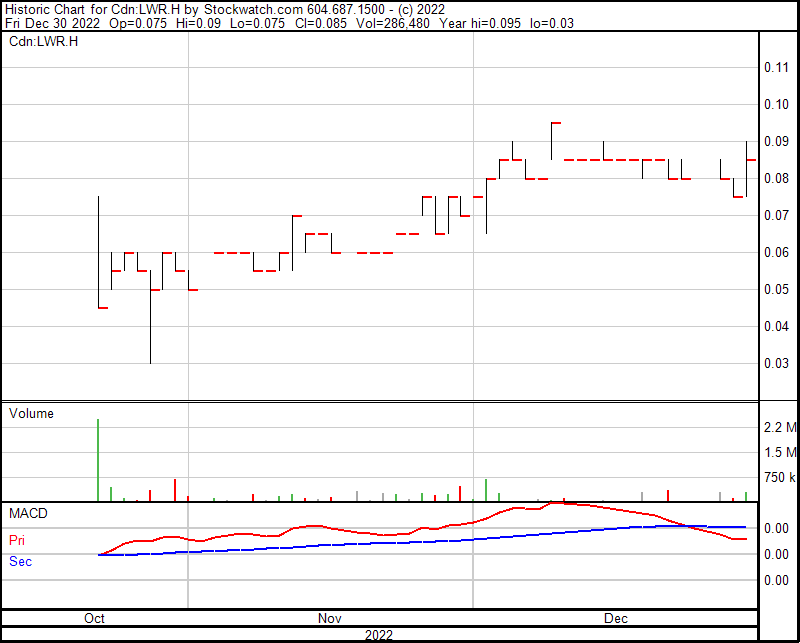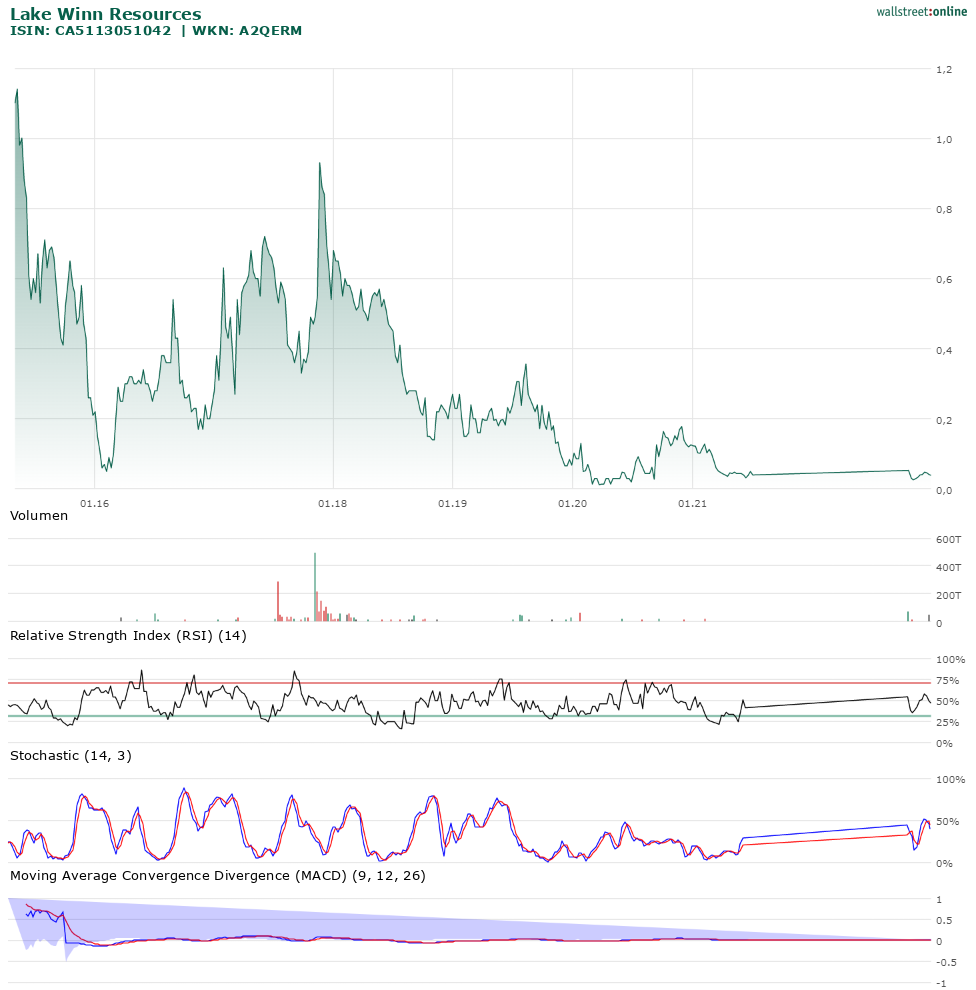Disseminated on behalf of Lake Winn Resources Corp. and Zimtu Capital Corp.
Yesterday on New Year‘s Day, Lake Winn Resources Corp. announced the start of a lithium exploration program at its LNPG (“Little Nahanni Pegmatite Group“) Property in Northwest Territories, Canada. This highly prospective lithium project has been kept on the back-burner for several years, but with lithium being arguably one of the hottest markets now, management is eager to ignite the rush into the region and reveal the merits of the project with a multi-phased exploration program backed by a recently closed $1-million financing. With just 52 million shares issued and a current market capitalization of $4 million, Lake Winn is taking the opportunity to unlock shareholder value with a property on the radar of some major industry players. When you hear opportunity knocking, it‘s time to take action for some unimagined glory!
Little Nahanni Pegmatite Rush
A day before New Year‘s Eve, the company Li-FT Power Ltd. (CSE: LIFT; market capitalization: $196 million) completed the acquisition of a private B.C.-numbered company which owns 2 early-stage lithium exploration properties: One near Yellowknife and the other one, called Cali Lease, located in the Little Nahanni Pegmatite Field of the MacKenzie mountains in Northwest Territories near the Yukon border and just a few kilometres from Lake Winn‘s LNPG claims.
Li-FT Power‘s CEO, Francis MacDonald, indicated in November, when proposing the amalgamation with the private B.C.-numbered company, that both the Yellowknife and Cali Lease projects were “held privately for 35 years without having any exploration work completed at a time when lithium was not an exciting commodity.“
To amalgate with the private company, Li-FT issued 18 million shares, each at a deemed price of $8.59 per share, which values the transaction at a whopping $154 million. In June 2022, Li-FT started trading on the CSE at $3 per share, reaching $16.50 in early December after announcing the transaction, and was last trading at $11.
Both the Yellowknife and Cali Lease properties were held dormant by the private company EREX International Ltd., which was acquired by the B.C.-numbered company earlier in 2022 and, according to a recent CBC article, there were “ some common shareholders“ between the numbered company and Li-FT Power. MacDonald said the numbered company approached Li-FT and they decided to amalgamate.
In this respect, it‘s highly interesting to find out that EREX has been staking certain claims of the LNPG Property which Lake Winn dropped earlier as management did not see much value in exploring those claims. EREX, now controlled by Li-FT, appears to have recognized the strategic opportunity of consolidating grounds around the Little Nahanni Pegmatite Field, which has been noted by Li-FT to “have greater than 275 complex rare element pegmatites over an area of 13 by 2.5 kilometers.“
Lake Winn‘s news-release of January 1, 2023:
Lake Winn Commences work on Lithium, Tantalum, Caesium pegmatite, Little Nahanni LI Property, Northwest Territories
Lake Winn Resources Corp. (“Lake Winn” or the “Company”) (TSXV:LWR.H) (Frankfurt: 82A2) (WKN: A2DFY5) (OTC:ASDZF) is pleased to announce that it has commenced exploration on its Little Nahanni Claims in the NT.
The claims cover the southern half of the Little Nahanni LTC pegmatite swarm that have been traced over a combined length of 13 km in mountainous terrain that is deeply incised by several east- or west-facing cirques. The sampled portions of the dyke swarms are up to 52.60 m wide. Each dyke swarm contains multiple dykes that range from 0.2 to 10 m in width. The dykes strike northerly and have near vertical dips. They are well exposed on cirque walls, but most of these areas are too steep to sample. Fortunately, relatively continuous bedrock exposures are accessible at the base of cliffs on the north and south side of cirques. Cirque floors are covered by overburden.
The company has commenced the following work in preparation for a drill program planned for the summer of 2023.
The work includes.
1. Permitting
2. An Archeology study.
3. A helicopter borne geophysical survey using the ultra-sensitive SQUID magnetometer, operated by DIAS
4. A satellite study including the use of a unique ground penetrating radar technique.
5. The are 1600m of historic core, to be scanned using the state of the art core scanner from Geologic AI
6. A road access study to aid in future permitting
7. Little Nahanni First Nation liaison.
8. Data compilation and re-interpretation of the previous work.
The program on the Li property will be managed by Archer, Cathro & Associates (1981) Limited (Archer Cathro).
Lake Winn Resources Update Zoom call will be held Jan 3, 2023 10:00 AM PST. The meeting will discuss this news release and have opportunity for shareholders to ask questions. Join Zoom Meeting by clicking this link at 9:55 on Tuesday:
https://us02web.zoom.us/j/88133334613?pwd=RWdFVlBPT1pheHoxTVhRODJOVHZNQT09us/j/88133334613?pwd=RWdFVlBPT1pheHoxTVhRODJOVHZNQT09
Meeting ID: 881 3333 4613
Passcode: 969076
Qualified Person
The Qualified Person for this news release is Buddy Doyle, AUSIMM, a Geologist with over 35 years of experience in mineral exploration, discovery, and evaluation. A Qualified Person under the provisions of the National Instrument 43-101.
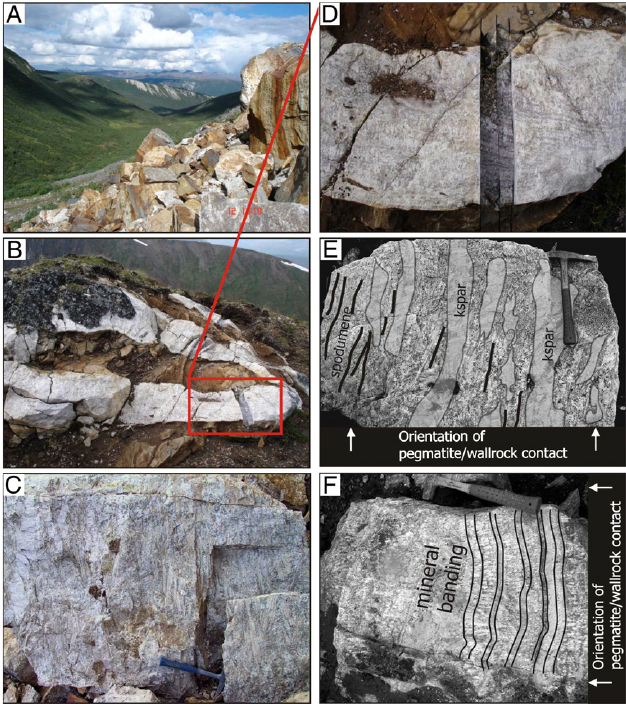
Full size / Samples of high-grade lithium mineralization at the LNPG Property.
When looking at the assays from past exploration at the LNPG Property, you may come to the early conclusion that the lithium grades are high but the widths are rather small. However, when looking at the figure entitled “Idealized Pegmatite System“, you may recognize in a heart-beat that the widths found to date (at or near surface) may very well just be the “tip of an iceberg“, which may lead you to the final conclusion that a large and lithium-rich pegmatite body could be waiting to be discovered with future drilling.
If the lithium grades at surface within these dykes were low, there would be no reason to continue exploring for wider mineralization at greater depths. However, since channel sampling at exposed dykes in 2016 showed respectable lithium grades, the search for deeper and much wider lithium mineralization is warranted – now more than ever before as lithium prices have sky-rocketed to a level 5-times higher than 6 years ago and 14-times higher than 2 years ago. And since those lithium-rich dyke swarms occur at high mountainous elevations, “greater depths“ may be just around the corner in the valleys of the LNPG Property.
Below figure (“Idealized Pegmatite System“) might be the most important aspect to understand Lake Winn‘s exploration model for the LNPG Property going forward:
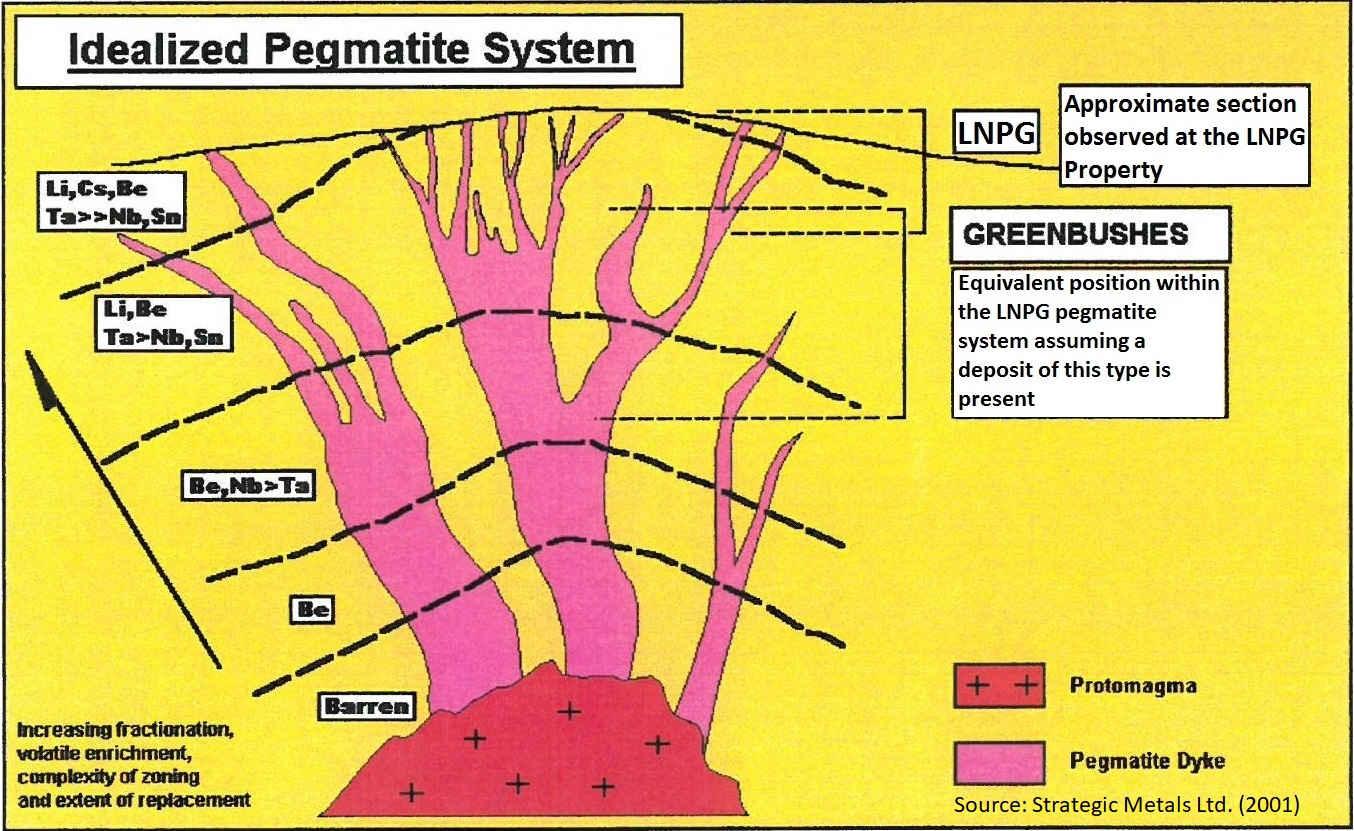
Full size / Cross-section through an idealized pegmatite system with interpreted erosion levels (sections) of the LNPG Property in comparison with the Greenbushes Lithium Pegmatite Deposit in Western Australia.
Past exploration at the LNPG Property has confirmed high grades of lithium “within a system of branching swarms of dykes that extend over 13km exposed strike length and up to 500m width,“ according to the Technical Report “Geology and Summary Report of the Little Nahanni Pegmatite Prospect” (2017), which also states the following:
• “Individual dykes within these `swarms´ are mostly 1-10m thickness... Natural exposure and drilling has demonstrated a vertical extent of 300m.“
• “Minerals of interest are spodumene, lithium micas, tantalite-columbite and cassiterite. Grades of up to 2% Li2O and 500g/t Ta2O5 are reported for individual dykes.“
• “The property has been explored sporadically since 1979. This work included soil and stream sediment geochemistry, chip and channel sampling of cliff faces and 1798m of diamond drilling.“
• “With the current increase in the demand of Li and Ta the property has become a significant prospect.“
• “Testing of the mineralization at depth is also an obvious target.“
The above figure “Idealized Pegmatite System“) shows the interpreted erosion level of the LNPG Property in comparison to the Greenbushes Deposit in Australia. When looking at the pictures in this report, you may come to the conclusion that the rugged terrain must be quite challenging for a potential mining scenario. However, you could also consider this mountainous area as fortunate when connecting the dots with that figure: The “fingers“ (thin dykes) at high elevations might lead to the “hand palm“ (thick dykes) near the valley, where drilling (and underground mining) horizontally into the mountain offers potential to tap into a large and rich lithium-tantalum body.
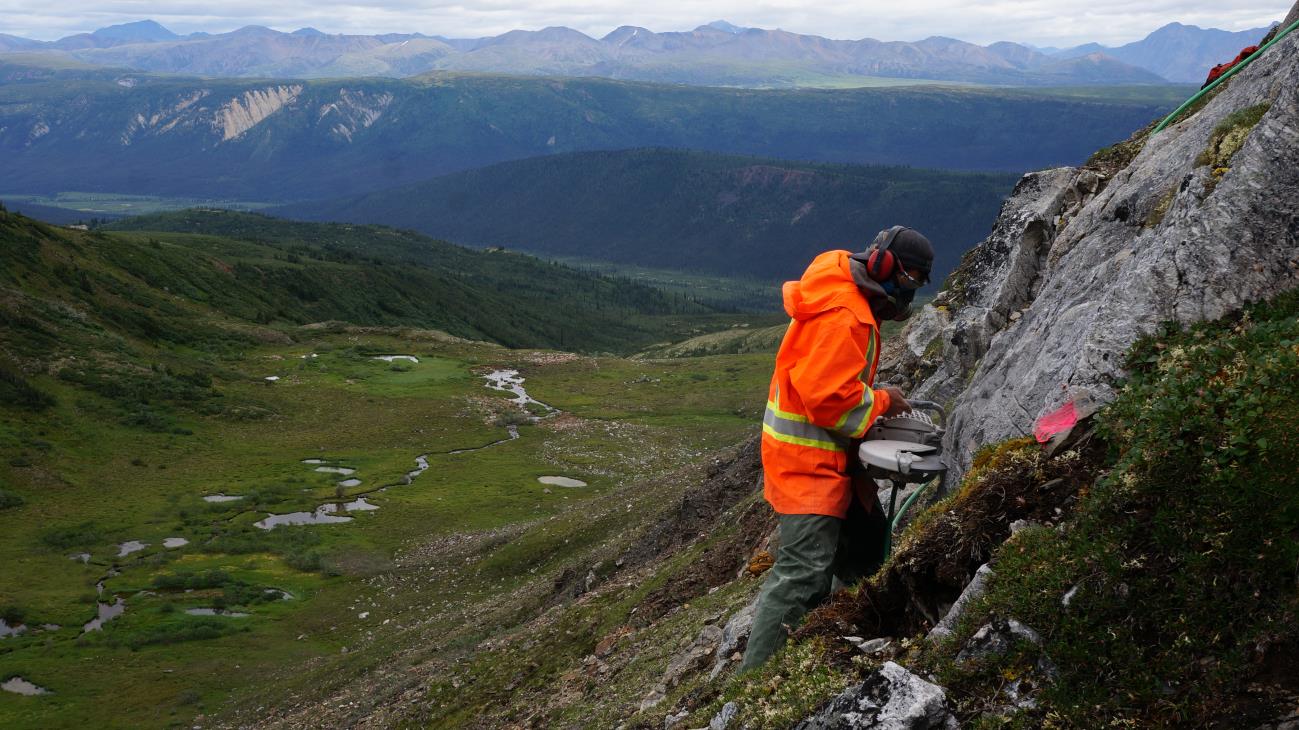
Full size / Channel sampling at exposed dykes at the LNPG Property in 2016 confirmed high grades of lithium.
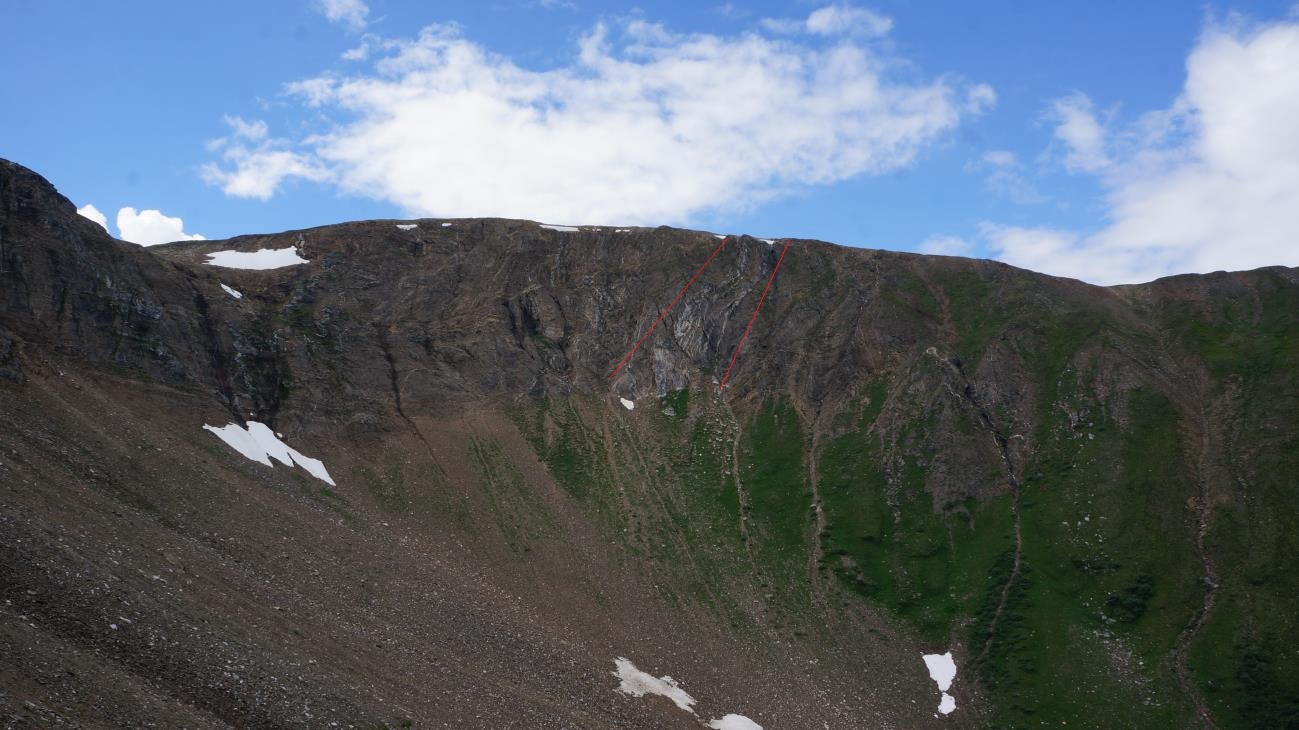
Full size / LNPG‘s Great Wall of China: North side of Cirque 3 showing a pegmatite dyke swarm. Note how the light-coloured dykes thicken at depth. Within a 52.6 m interval, 14 individual dykes were sampled in 2016 for a total thickness of 16.65 m grading 1.21% Li2O, 65.4 g/t Ta2O5 and 0.03% SnO2. An individual dyke located 77 m east of the Great Wall of China dyke swarm on the south side of Cirque 3 returned 1.63% Li2O, 52.9 g/t Ta2O5 and 0.01% SnO2 over 5.15 m.
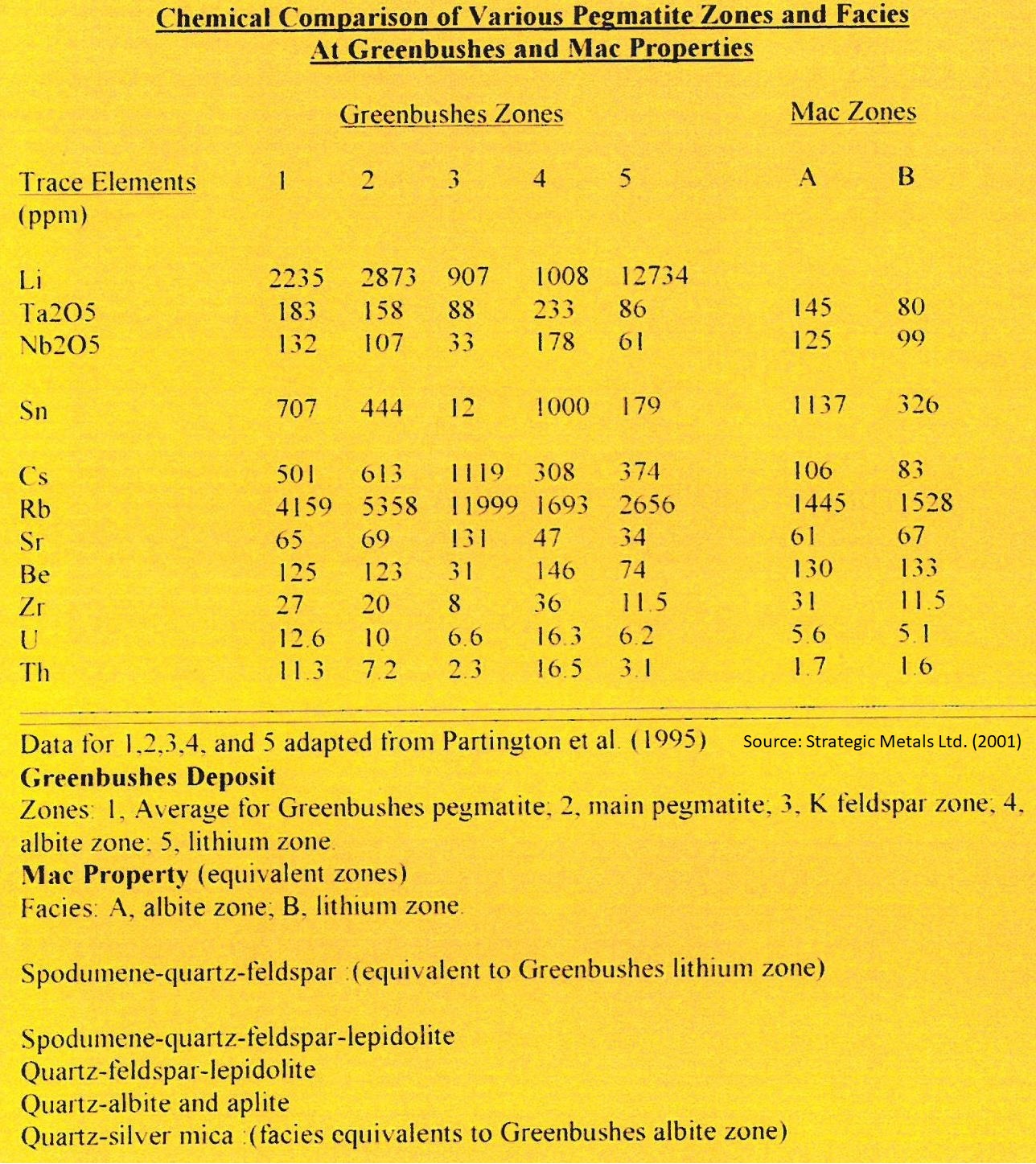
Full size / Comparison between pegmatite zones at Greenbushes and Mac (part of today‘s LNPG Property). Lithium grade conversion: 2,235 ppm Li divided by 10,000 = 0.2235% Li. To convert from Li to Li2O, use the factor 2.153: 0.2235% Li x 2.153 = 0.48% Li2O. Greenbushes´ highest grade pegmatite zone #5 averages 12,734 ppm Li = 1.2734% Li x 2.153 = 2.74% LiO2. The average of Greenbushes´ 5 pegmatite zones is 3,951 ppm Li = 0.3951% Li x 2.153 = 0.85% LiO2. This shows that the lithium grades encountered by channel sampling at the LNPG Property in 2016 are in line with Greenbushes´ average lithium deposit grades as of 1995.
Highlights from individual dykes from channel sampling at LNPG in 2016:
• 0.95 m @ 3.1% Li2O and 53.6 g/t Ta2O5
• 1.2 m @ 2.33% Li2O and 59 g/t Ta2O5
• 4 m @ 2.04% Li2O and 57.8 g/t Ta2O
• 1.25 m @ 1.83% Li2O and 67.3 g/t Ta2O5
• 3.75 m @ 1.67% Li2O and 41.4 g/t Ta2O
• 5.15 m @ 1.63% Li2O and 52.9 g/t Ta2O5
• 1.7 m @ 1.57% Li2O and 250.3 g/t Ta2O5
In 2007, historic channel samples returned up to 10 m @ 1.59% Li2O. Historic drilling in 2007 assayed 10.94 m @ 1.2% Li2O and 18.27 m @ 0.92% Li2O. A Qualified Person, as defined in National Instrument 43-101, has not done sufficient work on behalf of Lake Winn Resources Corp. to classify the historical grades reported herewithin as compliant with NI 43-101. Therefore, the historical grades should not be relied upon.
Excerpts from the Technical Report “Geology and Summary Report of the Little Nahanni Pegmatite Prospect” (2017):
• “Wengzynowski (2002) makes comparison between the Little Nahanni and Greenbushes (W.A.) pegmatites. Greenbushes was formed as a series of dykes, from hundreds of metres to kilometres in length (Partington et al., 1995)... Despite the Greenbushes deposit being formed during active deformation (and the Little Nahanni being very late to post deformation) there is similarity in pegmatite composition, if not in sequence of zoning. Partington et al., (1995) show that there is no evidence for a buried granite beneath Greenbushes. This is a real enigma! There is ample evidence for a relatively shallow granite batholith below Little Nahanni since a metamorphic aureole may be demonstrated by the presence of aluminosilicate porphyroblasts that post-date the main D1 deformation. Both pegmatites are on the scale of the same order of magnitude.“
• “The mineralogy of the Little Nahanni pegmatites is clearly of the LCT type and REL-Li class. Since a very large volume of granitic magma is required to produce the extremely fractionated late-stage magma for these pegmatites, an unexposed S-type batholith is expected. As an example of scale, in the study of the Tanco pegmatite London (2008) comments that a volume of 18,000 km3 of rock is estimated to be involved in the melting event. “It is easier to squeeze blood out of a rock than to squeeze a Tanco pegmatite out of the earth’s crust.” The Little Nahanni pegmatites (at perhaps ≤ 1km3) are not quite on the same scale as Tanco, but they still required fractionation of a specialized melt/hydrothermal fluid from a very large volume of granitic magma. Other pegmatites are known from the Nahanni region (eg., those associated with the large O’Grady batholith), but the Little Nahanni system is the one group of obvious extent, quite possibly due to its source granite being still well below the present level of erosion.“
• “The LNPG dikes originate from a single magmatic source with each dike essentially behaving as a closed system during propagation of the magma through to its eventual consolidation. The dikes show a wide range of magmatic fractionation up to levels comparable with highly evolved and mineralised granites and pegmatites from the Variscan orogeny in France and Germany (e.g., Raimbault et al. 1995 and Webster et al. 1997), the Khangilay Li-F granites of Transbaikalia, Russia and the Tin Mountain pegmatite in South Dakota (Walker et al. 1986).”
Greenbushes is the world‘s largest hard-rock lithium mine in terms of reserves, resources, production, and capacity, producing ~1.95 million t of lithium spodumene annually (2019). It is renowned for containing the world‘s highest-grade quality lithium spodumene. The mine is owned and operated by Talison Lithium PLC (since 2014 a joint venture between Tianqi Lithium Corp. and the Albemarle Corp.), whose website states the following:
• “The Greenbushes pegmatites belong to the Lithium-Caesium-Tantalum family. The Greenbushes pegmatite deposit intrudes along a major northwest regional fault zone...The pegmatite consists of a large main zone over 3 kms long and up to 300m wide with numerous smaller pegmatite dykes and pods flanking the main body. The Greenbushes pegmatites are mineralogically zoned in a lenticular interfingering style along strike and down dip. The lithium zone is over 2 km long and enriched with the lithium-bearing mineral spodumene, which often makes up 50 percent of the rock.“
• “Talison Lithium and its predecessor companies have been producing lithium from the Greenbushes lithium operations since 1983 and Greenbushes is recognised as the longest continuously operated mining area in Western Australia. Tin mining commenced in the Greenbushes area in 1888 and mining of tantalum commenced in the 1940s. Initial development of the ore body at Greenbushes started in 1983 with the first lithium processing plant commissioned in 1985.“
“[The] Greenbushes pegmatite is a giant pegmatite dike of Archean age with substantial Li-Sn-Ta mineralization, including half the world’s tantalum resource.” The mine is estimated to have resources of 8.7 million t (19 billion pounds) LCE and reserves of 6.8 million t (15 billion pounds) LCE. (Source)
Below pictures of the Greenbushes Lithium Mine in Western Australia show light-coloured pegmatite dykes and large ore bodies near surface in a relatively flat terrain, facilitating an open-pit mining operation:
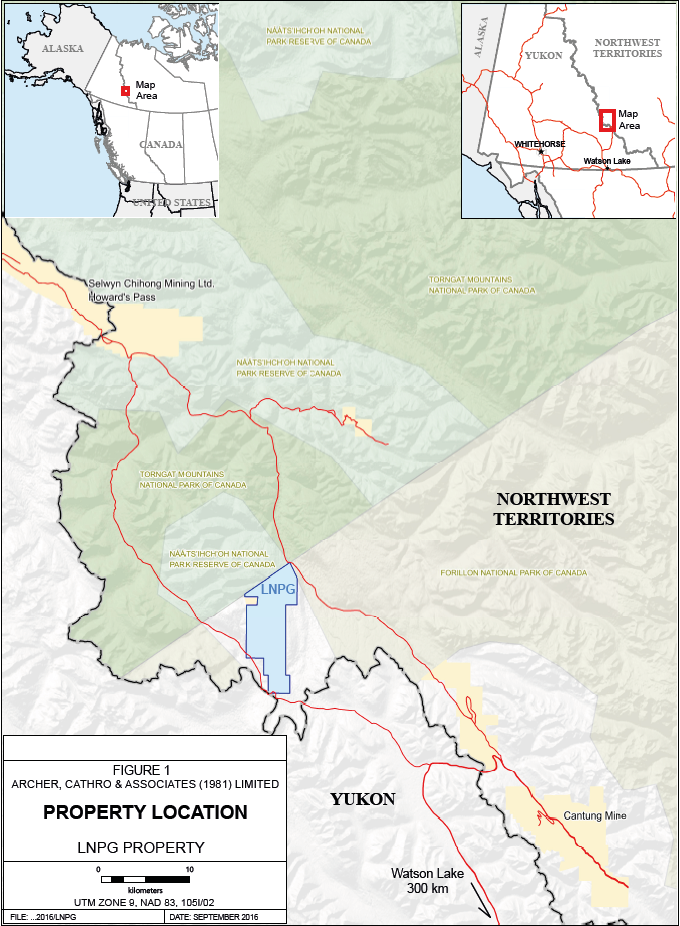
Full size / Source / The LNPG Property is located 30 km northwest of the Cantung Tungsten Mine, which operated from 1962 to 1986, again from 2002 to 2003, and from 2005. Production was suspended from October 2009 to October 2010. The mine owner, North American Tungsten Corp., went bankrupt in 2015 and the mine closed in October of that year. The federal government of Canada now owns the mine. As of 2017, the mine remained closed, with the possibility of being opened to process a nearby lithium deposit.
The Howard‘s Pass district is one of the largest undeveloped Zn-Pb districts in the world. Within the interior Cordillera of northwestern Canada, the Howard’s Pass Zn-Pb district extends for over 40 km and consists of 15 currently undeveloped orebodies. These Zn-Pb deposits are hosted in strata of the Selwyn basin and have been classified as sedimentary exhalative (SEDEX) type. Collectively, they contain more than 154 million t of indicated resources and 237 million t of inferred resources. The Howard’s Pass district of sedimentary exhalative (SEDEX) Zn-Pb deposits comprises 14 Zn-Pb deposits that contain an estimated 400.7 million t of sulfide mineralization grading 4.5% Zn and 1.5% Pb. The Howard‘s Pass district is located within the Selwyn Basin, a metallogenic province that is primarily known for its worldclass Zn-Pb (±Ag ± Ba) sediment-hosted deposits.
LNPG‘s Berlin Wall: In 2016, a 35.8 m interval was channel sampled across part of the Berlin Wall on the north side of Cirque 4. This interval yielded 0.29% Li2O, 12.3 g/t Ta2O5 and 0.01% SnO2 across 35.8 m, with dykes within it averaging 1.5% Li2O, 63.9 g/t Ta2O5 and 0.05% SnO2 across a total of 6.9 m. The best individual dyke within the swarm returned 2.04% Li2O, 57.8 g/t Ta2O5 and 0.05% SnO2 over 4 m. On the south side of Cirque 3, a portion of the Berlin Wall swarm returned 1% Li2O, 21.3 g/t Ta2O5 and 0.01% SnO2 across 4.45 m, including 1.95 m of dyke material that graded 2.29% Li2O, 48.7 g/t Ta2O5 and 0.01% SnO2.
LNPG‘s Great Wall of China: In 2016, a 52.6 m interval across the on the north side of Cirque 3 returned a weighted average grade of 0.38% Li2O, 20.7 g/t Ta2O5 and 0.01% SnO2. Within the 52.6 m interval, 14 individual dykes were sampled for a total thickness of 16.65 m. The combined thickness of the dykes graded 1.21% Li2O, 65.4 g/t Ta2O5 and 0.03% SnO2. A 19.7 m interval across a portion of the Great Wall of China on the south side of Cirque 3 averaged 0.5% Li2O, 21.3 g/t Ta2O5 and 0.01% SnO2 over 19.7 m, including 4 dykes totaling 7 m that graded 1.41% Li2O, 59.9 g/t Ta2O5 and 0.04% SnO2. An individual dyke located 77 m east of the Great Wall of China dyke swarm on the south side of Cirque 3 returned 1.63% Li2O, 52.9 g/t Ta2O5 and 0.01% SnO2 over 5.15 m.
During the 2016 exploration program, a total of 81 channel samples were cut across parts of the LCT pegmatite dyke swarms which comprise the Prison Wall, Berlin Wall, Great Wall of China and Hadrian’s Wall dyke swarms within Cirques 3 and 4. At the LNPG Property, lithium-cesium-tantalum (“LCT“) pegmatite dyke swarms, containing the lithium-bearing mineral spodumene, have been traced over a combined length of 13 km in mountainous terrain that is deeply incised by several east- or west-facing cirques. The sampled portions of the dyke swarms are up to 53 m wide. Each dyke swarm contains multiple dykes that range from 0.2-10 m in width. The dykes strike northerly, have near vertical dips, and are well exposed on cirque walls, but most of these areas are too steep to sample. Fortunately, relatively continuous bedrock exposures are accessible at the base of cliffs on the north and south side of cirques. Cirque floors are covered by overburden.
The best historic dyke interval reported to date was 1.59% Li2O over 10 m (Wengzynowski, 2002). This dyke was not re-located in 2016. A Qualified Person, as defined in National Instrument 43-101, has not done sufficient work on behalf of Lake Winn Resources Corp. to classify the historical grades reported herewithin as compliant with NI 43-101. Therefore, the historical grades should not be relied upon.
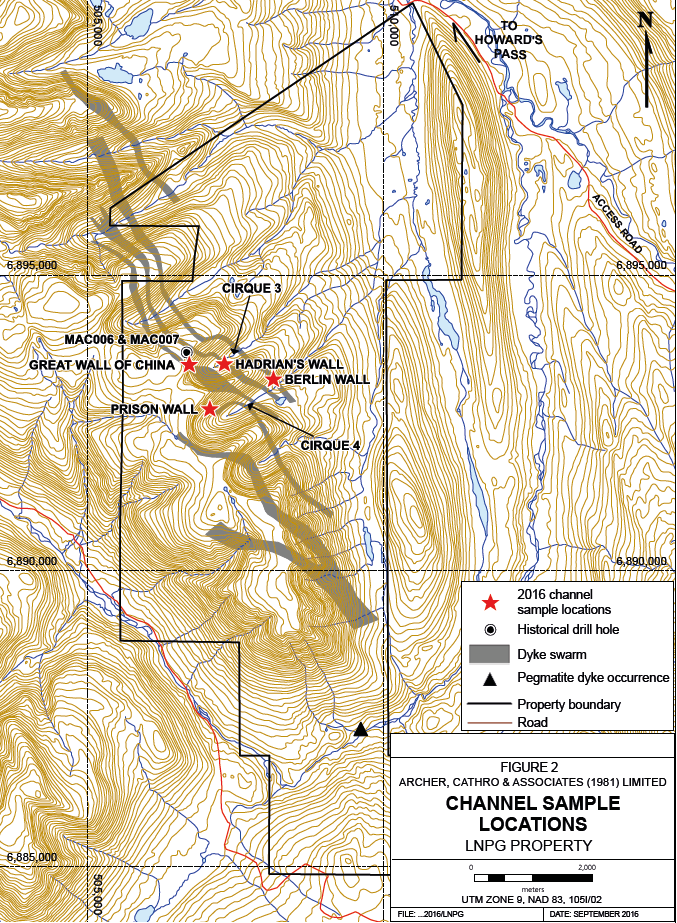
Full size / Source / A gated road extends northwest from the Cantung Tungsten Mine and passes within 5 km of the LNPG Property. This road is projected to be the main access road for the Howard‘s Pass SEDEX base metal Project, one of the world‘s largest undeveloped zinc-lead deposits (owned by Selwyn Chihong Mining Ltd. of China). The mineralized horizon is generally 20-30 m thick.
As the historic map below shows, previous exploration at the MAC Property (now part of the LNPG Property) focused on tantalum (and not lithium due to low prices at that time). Pegmatites on the MAC Property were first documented in 1961 by Canada Tungsten Mining Corp. The tantalum potential was first recognized by UBC professor L. Groat doing a pegmatite study in Northern Cordillera between 1992 and 1996. The study identified tantalum oxide but did not determine its abundance. Strategic Metals Ltd. (and its wholly owned subsidiary War Eagle Mining Company Inc.) staked the MAC Property in 2000 and verified the tantalum potential in specimens collected during staking. The company‘s 2001-program (chip and channel sampling) was the first systematic evaluation of dykes within the MAC Property. (Source: Strategic Metals Ltd., 2001)
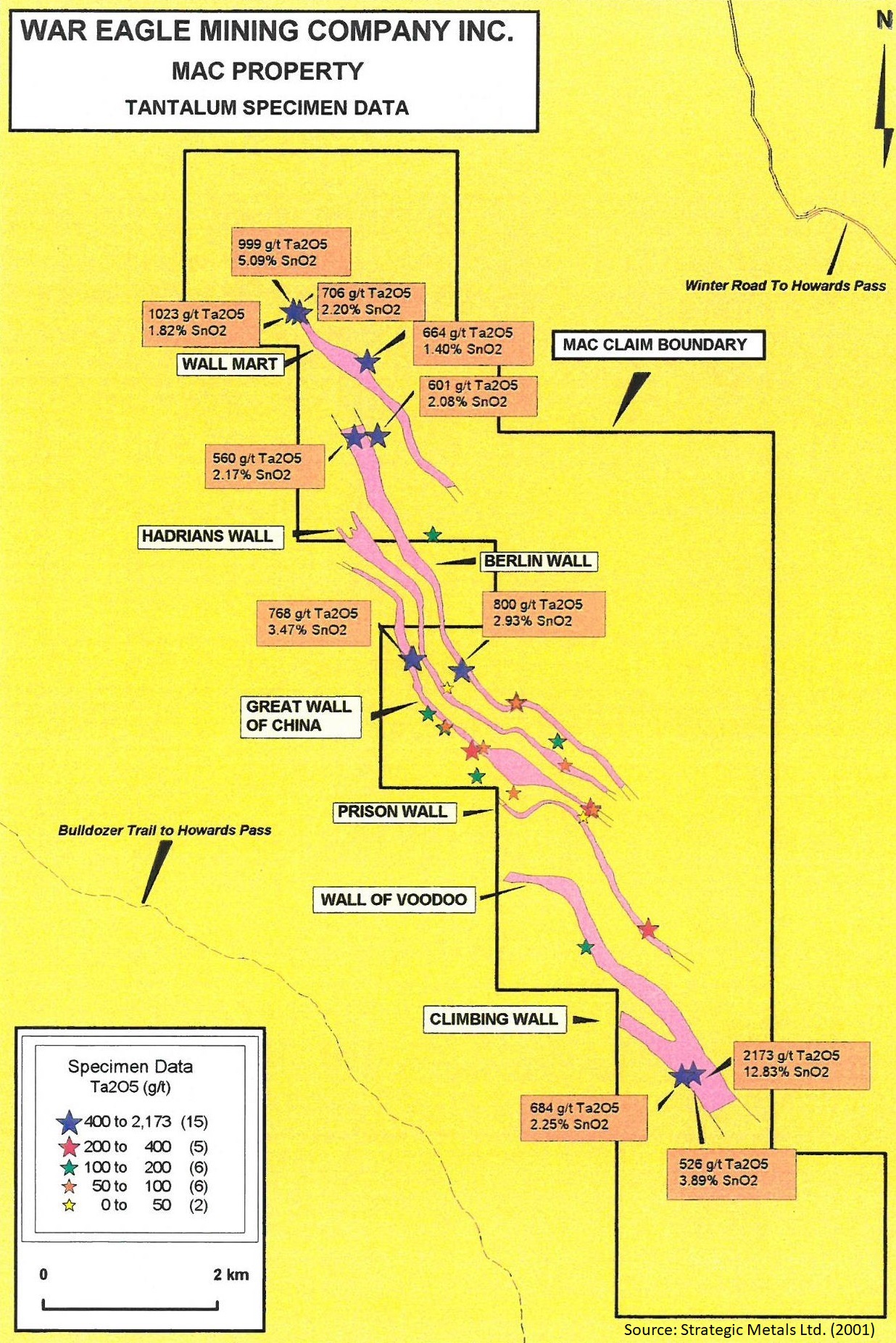
Full size / A Qualified Person, as defined in National Instrument 43-101, has not done sufficient work on behalf of Lake Winn Resources Corp. to classify the historical grades reported herewithin as compliant with NI 43-101. Therefore, the historical grades should not be relied upon.
At the LNPG Property, individual dykes – enriched with lithium and tantalum – are up to 10 m wide and may occur in swarms of up to 25 individuals. The picture below shows an outcropping dyke swarm at LNPG‘s Climbing Wall property section looking east (not sampled in 2016). Below picture is from LNPG‘s previous operator Strategic Metals Ltd. (2001), which company focused only on tantalum due to low lithium prices at that time. Lake Winn‘s management believes that the time has never been as favorable as today to unlock LNPG‘s lithium potential as the world is scrambling for new sources of lithium.
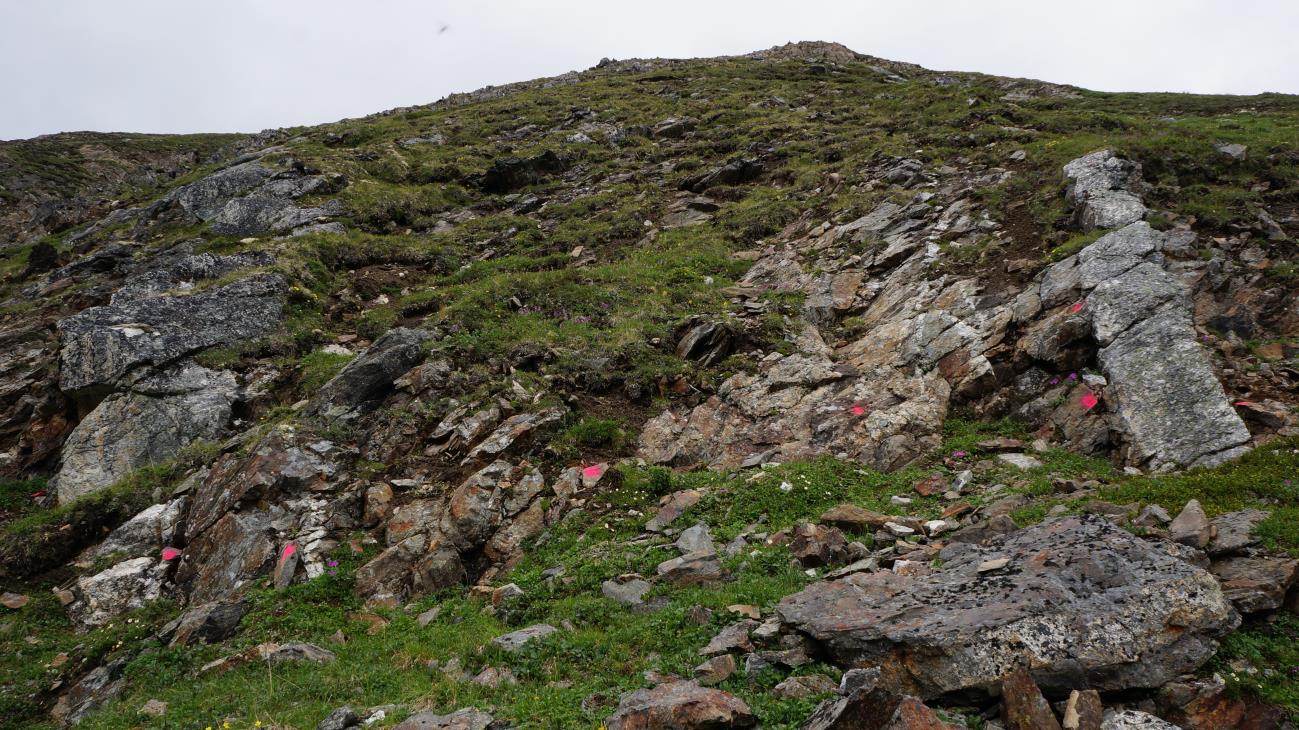
Full size / Example of channel sampling interval layout from the 2016 exploration program at the LNPG Property. (Pictures below were taken during the 2016 exploration program.)
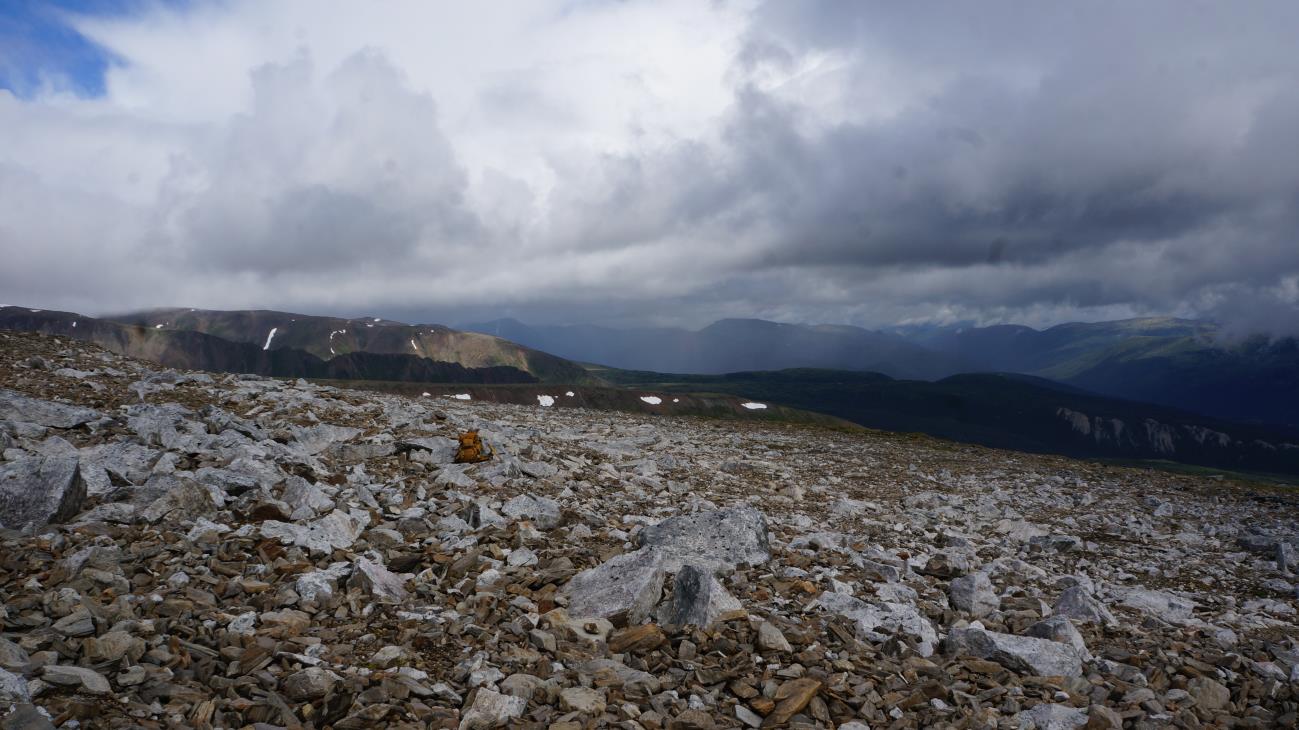
Full size / LNPG‘s Great Wall of China: Ride top near the historic holes MAC006 and MAC007, drilled in 2007 with high lithium oxide grades of 1.2% Li2O over 10.94 m (MAC 007) and 0.92% over 18.27 m (MAC 006). It is unclear if these intervals comprise single dykes or dykes and intervening wallrocks. The collars for MAC 007 and 006 were relocated in 2016 on the ridge north of Cirque 3. The 2007 drill core is stored at a gated compound at Finlayson Lake in southeastern Yukon. Cautionary note on historic data: A Qualified Person, as defined in National Instrument 43-101, has not done sufficient work on behalf of Lake Winn Resources Corp. to classify the historical grades reported herewithin as compliant with NI 43-101. Therefore, the historical grades should not be relied upon.
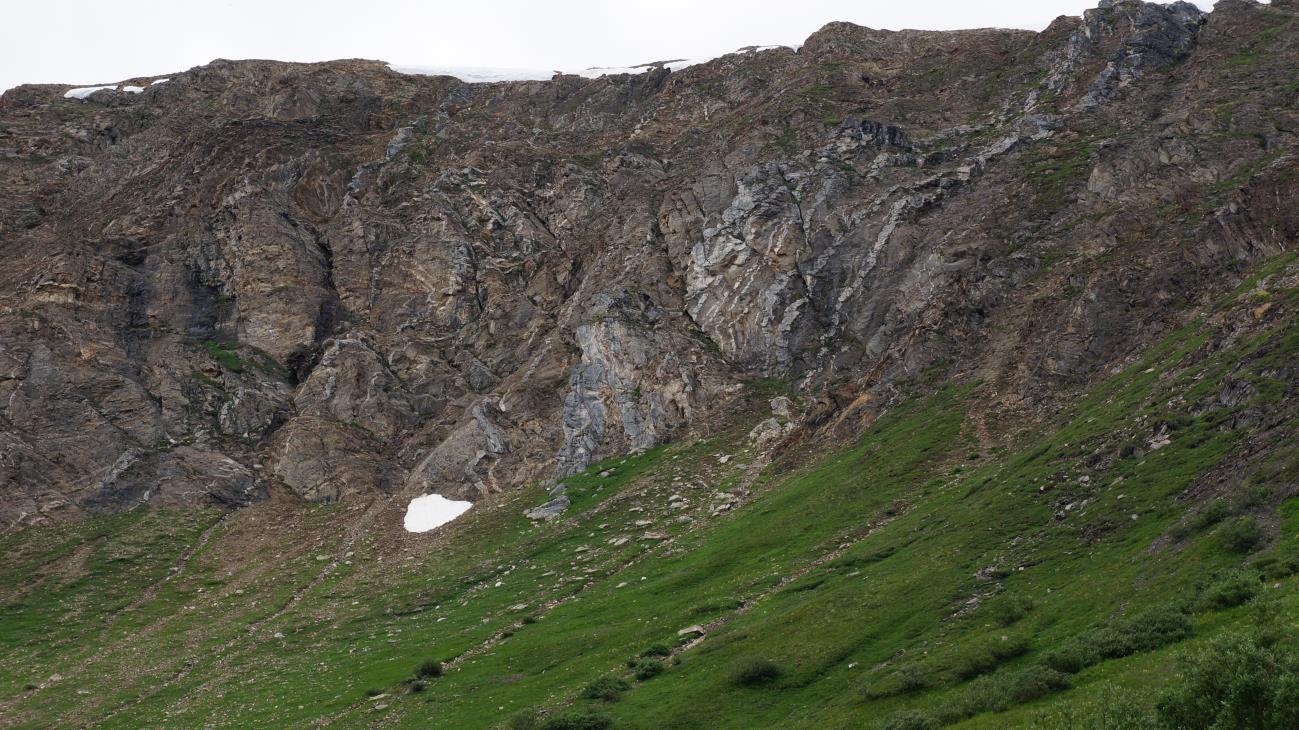
Full size / LNPG‘s Great Wall of China: North side of Cirque 3 showing light-coloured pegmatite dyke swarms thickening at depth.
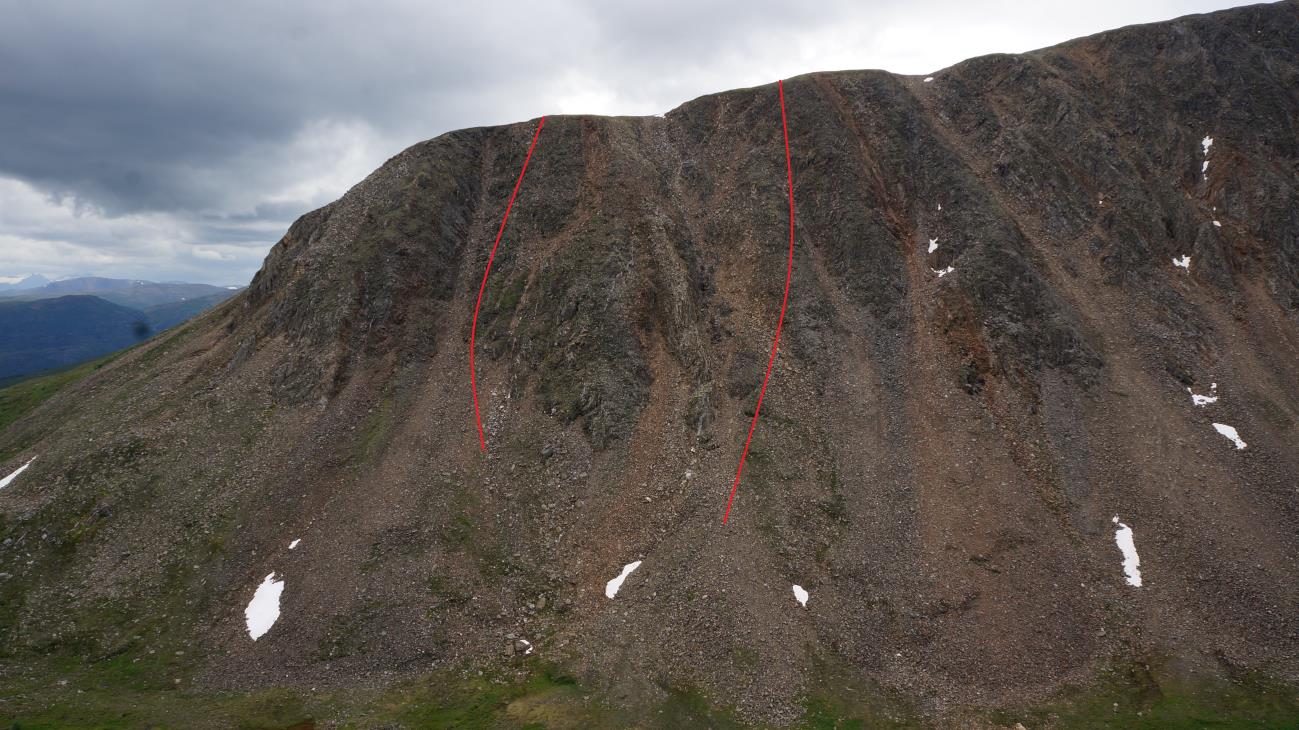
Full size / LNPG‘s Great Wall of China: South side of Cirque 4 showing light-coloured pegmatite dyke which was not sampled during the 2016 exploration program.
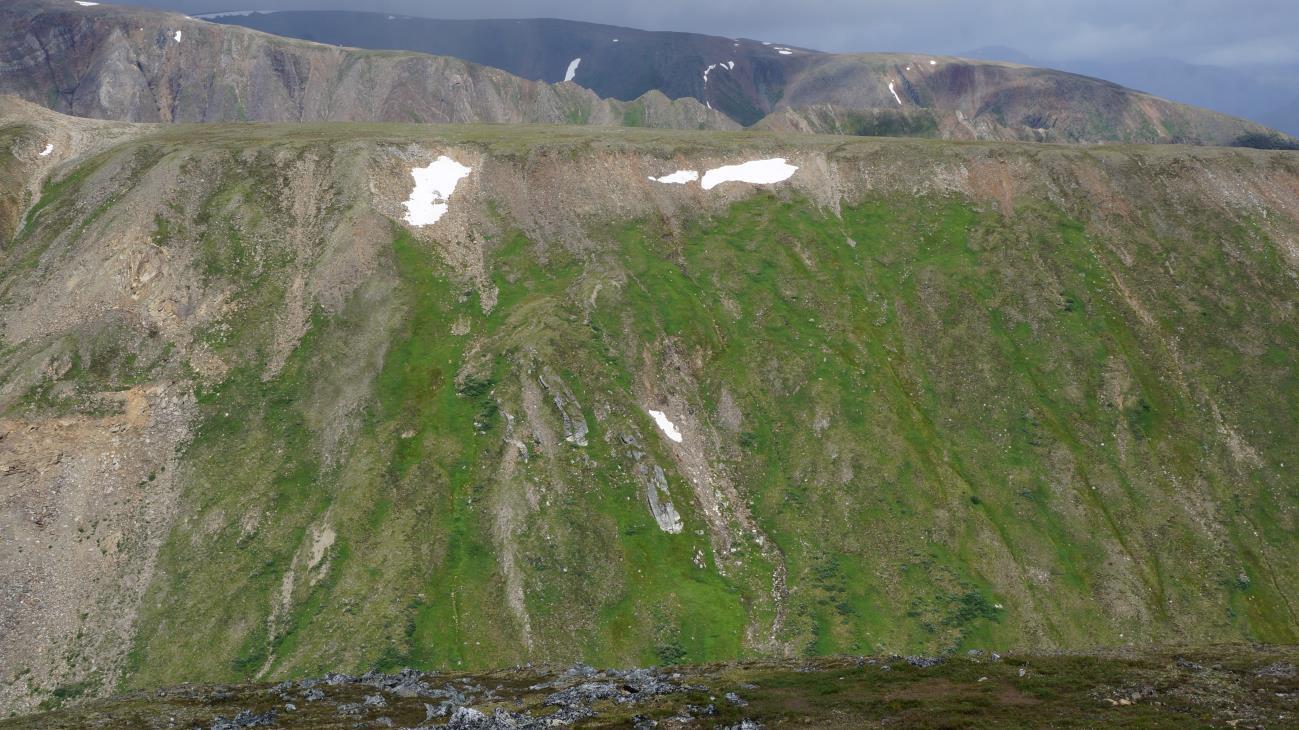
Full size / LNPG‘s Great Wall of China: North side of Cirque 2 showing light-coloured pegmatite dyke which was not sampled during the 2016 exploration program.
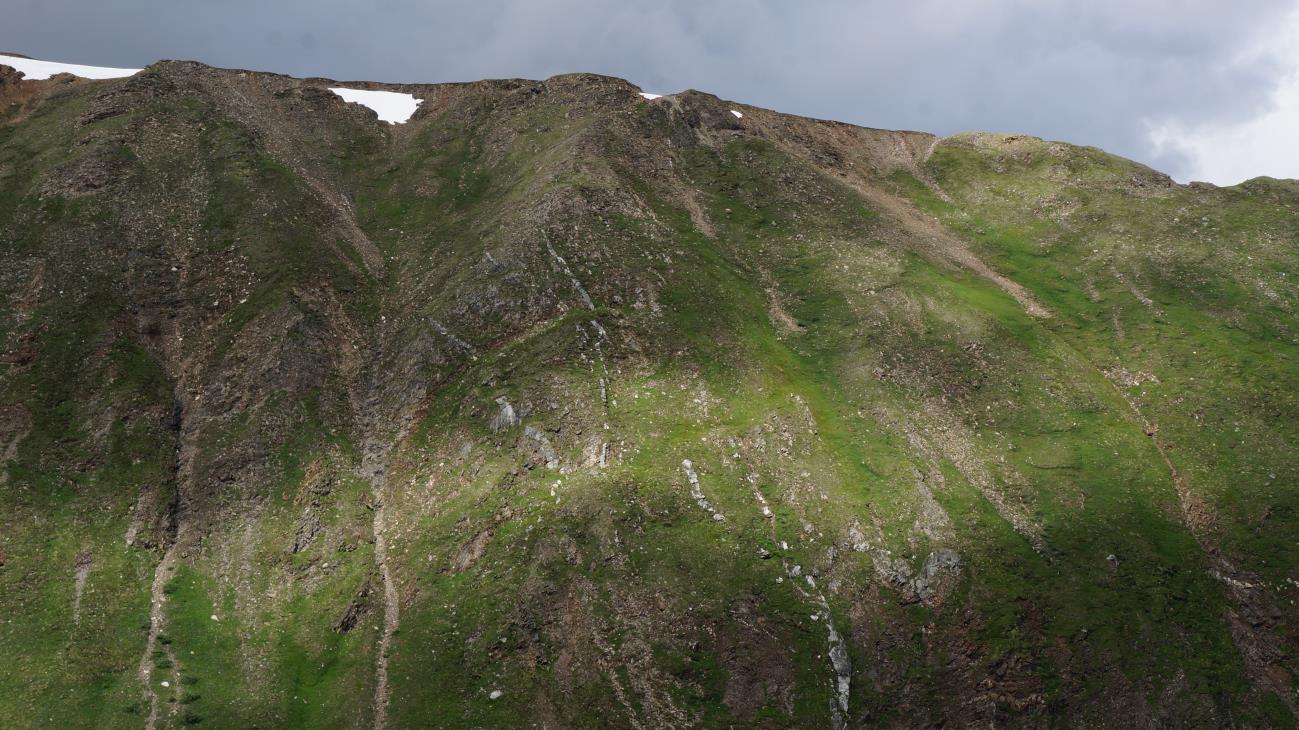
Full size / LNPG‘s Prison Wall: North side of Cirque 4 showing light-coloured pegmatite dykes thickening at depth. In 2016, a 16.8 m interval was channel sampled across an exposed portion: A total of 4.4 m of dyke material graded 1.12% Li2O, 55 g/t Ta2O5 and 0.05% SnO2. Two individual dykes located 13 m and 27 m northeast of the dyke swarm were also sampled, returning 0.87% Li2O, 56.4 g/t Ta2O5 and 0.03% SnO2 across 1.9 m and 1.57% Li2O, 250.3 g/t Ta2O5 and 0.95% SnO2 across 1.7 m, respectively.
According to the Technical Report “Geology and Summary Report of the Little Nahanni Pegmatite Prospect”, 2017): “An upper level progenitor magma chamber for the dikes is, so far undetected in the area, but was probably the heat source responsible for the zone of contact metamorphism. The chamber is expected to be located within the core of the Fork anticlinorium – such structures are typical traps for the ‘fertile’ granite magma associated with rare element pegmatites.“
Management & Directors
Patrick Power (President, CEO, Director)
Patrick is a seasoned venture capitalist and financier with over 20 years of experience as a stock market professional and as director of public companies. He also serves as President and CEO at Arctic Star Exploration Corp. (TSX.V: ADD). Lake Winn Resources Corp. benefits from Patrick‘s wealth of experience as a savvy deal maker, an adept financier and as a results-driven leader of dynamic public companies. Lake Winn enjoys Patrick’s large network of contacts within the industry, his enthusiasm and his efforts as a member of the audit and remuneration panels.
Buddy Doyle (VP Exploration, Director)
Buddy has 25 years experience in mineral exploration. He also serves as VP Exploration at Arctic Star Exploration Corp. He worked for Rio Tinto PLC for over 23 years, most recently he was Exploration Manager/Vice President of Kennecott Canada Exploration Inc. (owned by Rio Tinto), in charge of diamond exploration in North America. He was a key member of the Kennecott Exploration Australia team that discovered the multi-million ounce Minifie gold deposits at Lihir in 1987-1988 and led the team which discovered the Diavik diamond deposits in 1994-1995. Few geologists have seen 2 projects from discovery through to decision to mine. Buddy is recognized by his peers in the industry as an authority on diamond exploration and kimberlite geology, and has authored/co-authored numerous papers on these subjects. He was awarded the 2007 Hugo Dummitt Award for excellence in diamond exploration. Since leaving Rio Tinto, Buddy remains active in the diamond sector through consultancy and non-executive directorships. He brings to Lake Winn a disciplined scientific approach to mineral exploration and managerial skills that have a proven track record. Buddy holds a BSc in Applied Geology from the Queensland University of Technology.
Binny Jassal (CFO, Director)
Binny brings over 20 years of accounting and management experience to Lake Winn. He is a member of Certified General Accountants in Canada, fellow member of Association of Chartered Certified Accountants in London, England, and holds a Certificate in Accounting & Finance from Ryerson University Toronto. Previously, Binny has worked in various accounting positions (including public companies) within the manufacturing, IT and telecommunication sectors. He joined the Company in May 2006 and has been an important member of the team working on the financial and corporate side of the operations.
Saf Dhillon (Director)
Saf has worked in the banking, investment and securities industries for the last 25 years for various companies in both the public and private markets. During this time, he assisted in raising over $100 million in the capital markets as both a director and in business development. The majority of his time focused on the growth, development and corporate communications at U.S. Geothermal Inc. (formerly listed on the NYSE and TSX until its acquisition by Ormat Technologies Inc. in January 2018), since the early stages of the company public listing on the TSX Venture Exchange in 2004, as well as providing his skills and knowledge to several other private and public companies. U.S. Geothermal Inc. was a geothermal energy company focused on the development, production and sale of electricity from geothermal power plants in Idaho, Oregon and Nevada.
LIthium Carbonate Price:
Tantalum Price:
“Surging prices for lithium are intensifying a race between auto makers to lock up supplies and raising concerns that a shortage of the battery metal could slow the adoption of electric vehicles. Lithium carbonate prices in China, the benchmark in the fast-growing market, stand at about $71,000 a metric ton, according to price-assessment firm Benchmark Mineral Intelligence. That is almost four times as high as a year ago... But lithium keeps rising, driven by a pickup in electric-vehicles sales in China, the world’s biggest market for EVs... “Lithium is really following the Chinese EV market and that’s just taking off,” said Edward Meir, a metals consultant at brokerage ED&F Capital Markets. “This is a preview of what could await us in the U.S... Companies including General Motors Co., Ford Motor Co. and Volkswagen AG are racing to catch up with front-runner Tesla Inc., investing billions of dollars to bring EV factories online. All have struck deals with lithium producers to lock down scarce supplies... High prices have encouraged companies to embark on lithium projects in Latin America and Australia, the two biggest-producing regions. But analysts say they will take years to hit full speed and ease the shortage, in part because left-leaning South American governments are angling for greater control over their countries’ natural resources. Concerns about the effect of lithium mining on water supplies and other environmental worries also have held back efforts to crack open new deposits.“ (The Wall Street Journal, September 21, 2022)

Full size / Chart as of early 2022.
Excerpts from S&P Global Commodity Insights (January 2022):
During the last lithium price bear run, from mid-2018 to mid-2020, investments shriveled from the specialty chemical. In early 2018, a lot of new spodumene ore capacity started running from previous investments in anticipation to an expected EV boom that didn‘t start until the second half of 2020; the oversupply crashed prices and halted investments.
This time, the situation is completely different because demand is solid and growing much faster than supply. EV sales accounted for almost 20% of new car sales in China and over 25% in the European Union in recent months, forcing suppliers to try accelerating expansion and new projects. Financing and permitting, however, are considered significant hurdles.“ Although the battery industry has been investing significantly in downstream battery capacity to power the surging EV demand, lithium is still getting less funding than required – and such investment could be too late to prevent a structural deficit in the coming years. “Unfortunately, battery capacity can be built much faster than lithium projects,” said Joe Lowry, president of consulting firm Global Lithium. “The lack of investment in lithium capacity over the past five years will extend the supply shortage.”
The situation is so critical that Lowry didn’t want to make demand forecasts beyond 2027 – the supply-demand imbalance could be so serious that supply might end up capping demand, so forecasting beyond that could be misleading, he said. “Even well-capitalized major lithium companies have struggled to meet their expansion targets,” Lowry said. “New producers have seen their project timelines extended in many cases due to Covid and related supply chain issues along with their ‘learning curves’. OEMs and battery producers that assumed ‘market forces’ would ensure adequate battery raw materials are finally taking note of the supply-demand issue but much too late to solve the problem in the near to mid-term.” The outlook described by Lowry is confirmed by Platts’ comparison between the expected supply and the expected demand until 2030 [...], which shows that supply should not reach the projected 2 million mt demand by the end of the decade. [End of quote]

Full size / With a price increase of 738%, lithium was the best performing metal between January 2021 and March 2022 (average annual increase in 2010s: 13%; largest annual increase in 2010s: 77%).

Full size / Chart as of mid-2022.
“Lithium is a key raw material for electric vehicles and energy storage systems, but the lack of investment in new supply in previous years might generate a structural deficit throughout this decade, data from the expected supply versus expected demand (both until 2030) demonstrates.” (S&P Global Commodity Insights, January 2022)
“Mining companies need to invest nearly $1.7 trillion in the next 15 years to help supply enough copper, cobalt, nickel and other metals needed for the shift to a low carbon world, according to consultancy Wood Mackenzie... Wood Mackenzie analyst Julian Kettle calculated miners needed to invest about $1.7 trillion during the next 15 years to deliver a two-degree pathway — where the rise in global temperatures since pre-industrial times is limited to 2°C.” (Reuters, 2021)
“We believe that mining has to happen more in rich countries. Relying on materials sourced in faraway places means that consumers and regulators ignore the social and environmental impacts that enable their overconsumption. This has to change. Reducing overconsumption will become feasible when rich country governments approve more mines, allowing their citizens to experience the impacts of their overconsumption... In a scenario like this, `Big Lithium´ could look radically different from `Big Oil´. It could be an industry that truly exists to serve people and the environment.“ (“Big Lithium Will Be Built, But By Who?“, 2022)
Company Details

Lake Winn Resources Corp.
Suite 1100 – 1111 Melville Street
Vancouver, B.C. V6E 3V6 Canada
Phone: +1 604 218 8772
Email: info@lakewinn.ca
www.lakewinn.ca
CUSIP: 511305 / ISIN: CA5113051042
Shares Issued & Outstanding: 52,056,636
Canadian Symbol (TSX.V): LWR.H
Current Price: $0.085 CAD (12/30/2022)
Market Capitalization: $4 Million CAD
German Symbol / WKN: EE1A/ A2QERM
Current Price: €0.039 (01/02/2023)
Market Capitalization: €2 Million EUR
Contact:
Rockstone Research
Stephan Bogner (Dipl. Kfm.)
8260 Stein am Rhein, Switzerland
Phone: +41-44-5862323
Email: info@rockstone-research.com
www.rockstone-research.com
Lake Winn Resources News-Disclaimer: The Qualified Person for this news release is Buddy Doyle, AUSIMM, a Geologist with over 35 years of experience in mineral exploration, discovery, and evaluation. A Qualified Person under the provisions of the National Instrument 43-101. Neither the TSX Venture Exchange nor its Regulation Services Provider (as that term is defined in the policies of the TSX Venture Exchange) accept responsibility for the adequacy or accuracy of this release. Cautionary Statement Regarding “Forward-Looking” Information: This news release contains “forward-looking statements” including but not limited to statements with respect to Arctic Star’s plans, the estimation of a mineral resource, and the success of exploration activities. In this release, it is not certain if the kimberlite discovered will be economic or not as this depends on many factors. Forward-looking statements, while based on management’s best estimates and assumptions, are subject to risks and uncertainties that may cause actual results to be materially different from those expressed or implied by such forward-looking statements. There can be no assurance that such statements will prove to be accurate, as actual results and future events could differ materially from those anticipated in such statements. Factors that could affect our plans include our potential inability to raise funds as intended, and in such event, we may require all funds raised, if any, to be used for working capital rather than the intended uses as outlined. Accordingly, readers should not place undue reliance on forward‐looking statements. Arctic Star undertakes no obligation or responsibility to update forward‐looking statements, except as required by law.
Rockstone Disclaimer: This report contains forward-looking information or forward-looking statements (collectively "forward-looking information") within the meaning of applicable securities laws. Forward-looking information is typically identified by words such as: "believe", "expect", "anticipate", "intend", "estimate", "potentially" and similar expressions, or are those, which, by their nature, refer to future events. Rockstone Research, Lake Winn Resources Corp. and Zimtu Capital Corp. caution investors that any forward-looking information provided herein is not a guarantee of future results or performance, and that actual results may differ materially from those in forward-looking information as a result of various factors. The reader is referred to Lake Winn Resources Corp.´s public filings for a more complete discussion of such risk factors and their potential effects which may be accessed through its profile on SEDAR at www.sedar.com. Please read the full disclaimer within the full research report as a PDF (here) as fundamental risks and conflicts of interest exist. The author, Stephan Bogner, holds an equity position in Lake Winn Resources Corp., as well as in Zimtu Capital Corp., and is being paid by Zimtu Capital Corp. for the preparation, publication and distribution of this report, whereas Zimtu Capital Corp. also holds a long position in Lake Winn Resources Corp. Note that Lake Winn Resources Corp. pays Zimtu Capital Corp. to provide this report and other investor awareness services.

